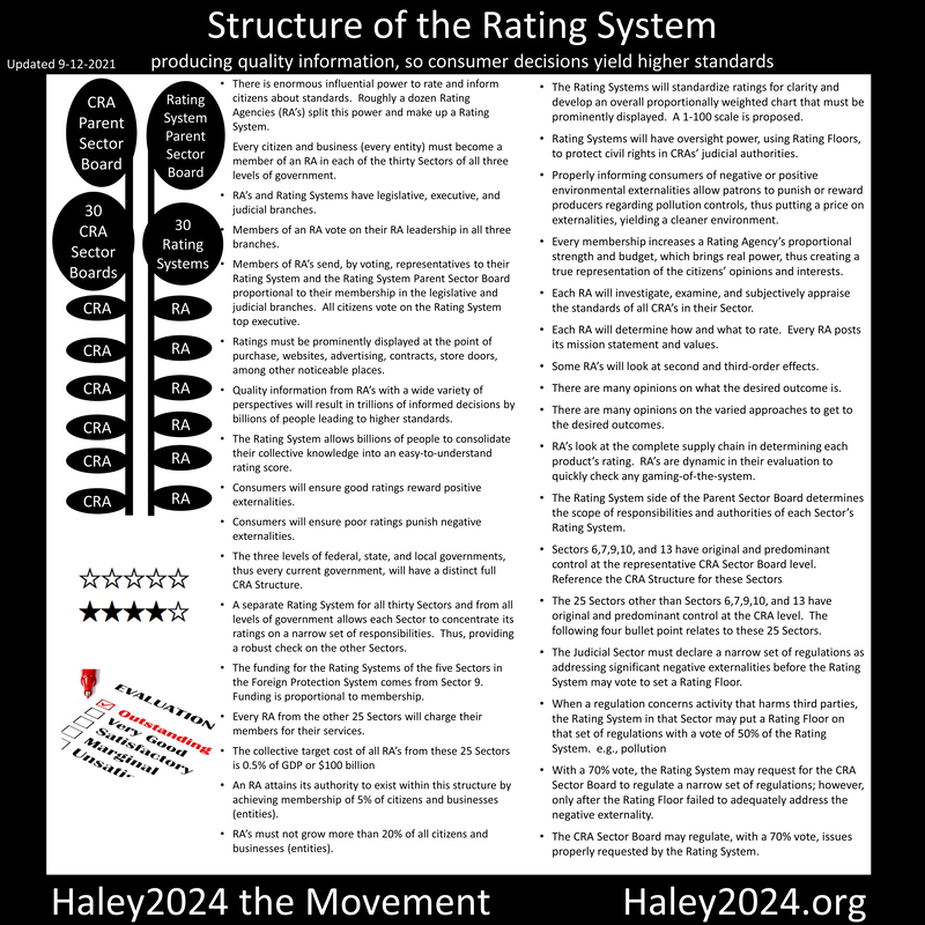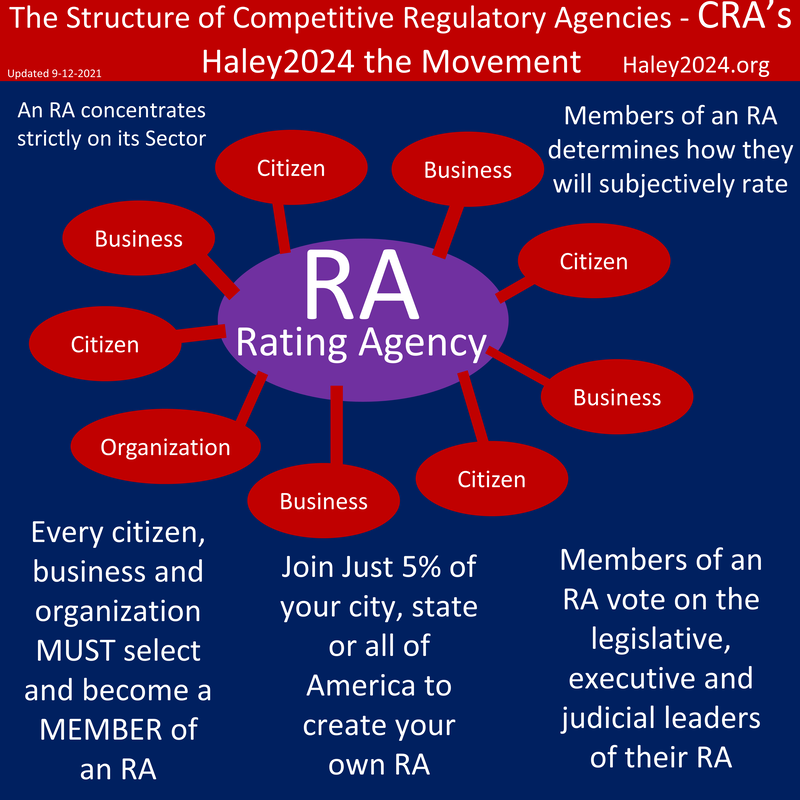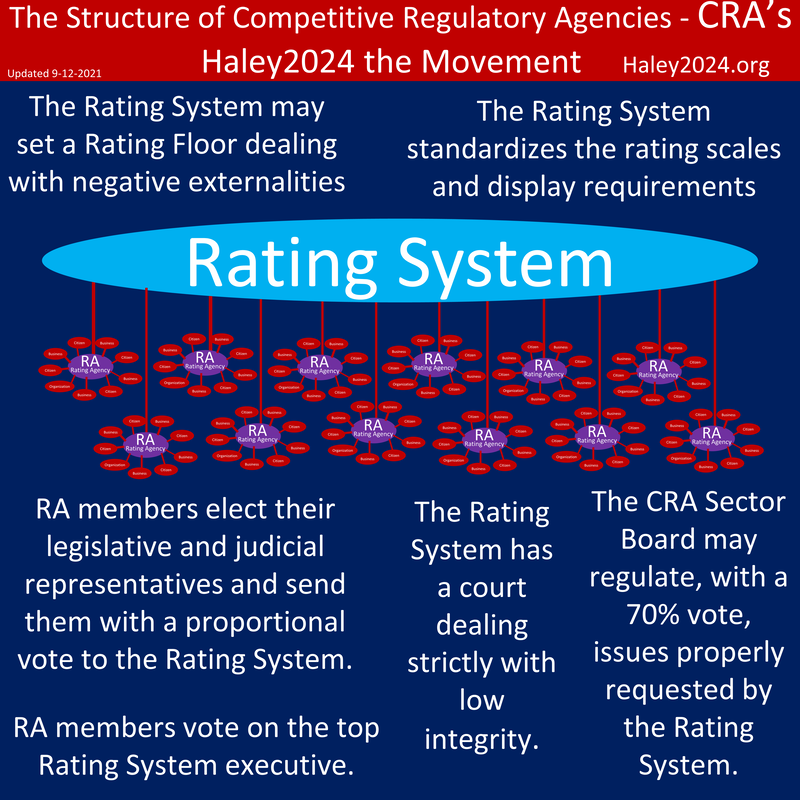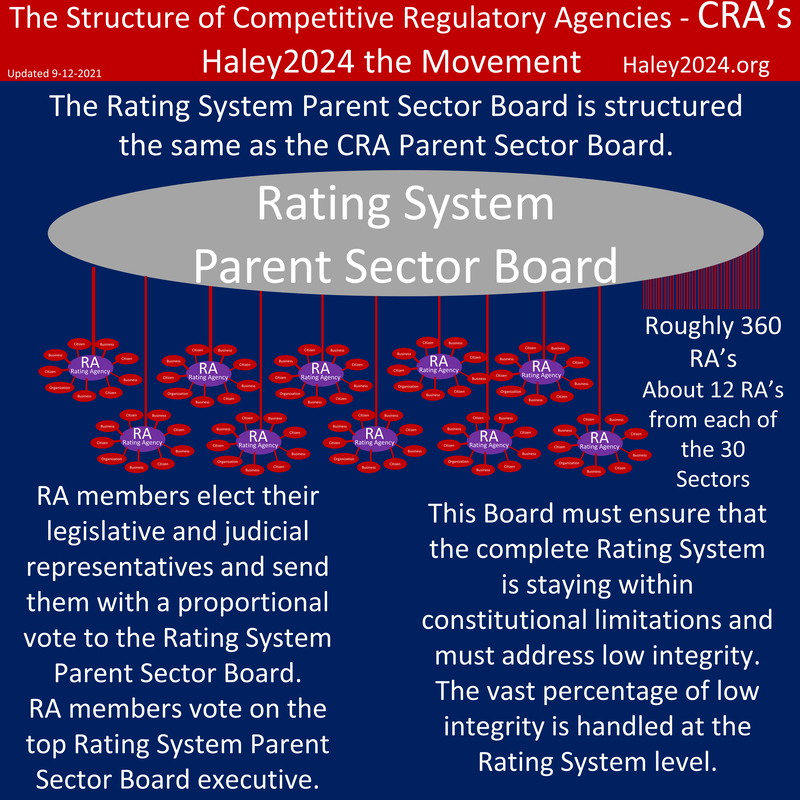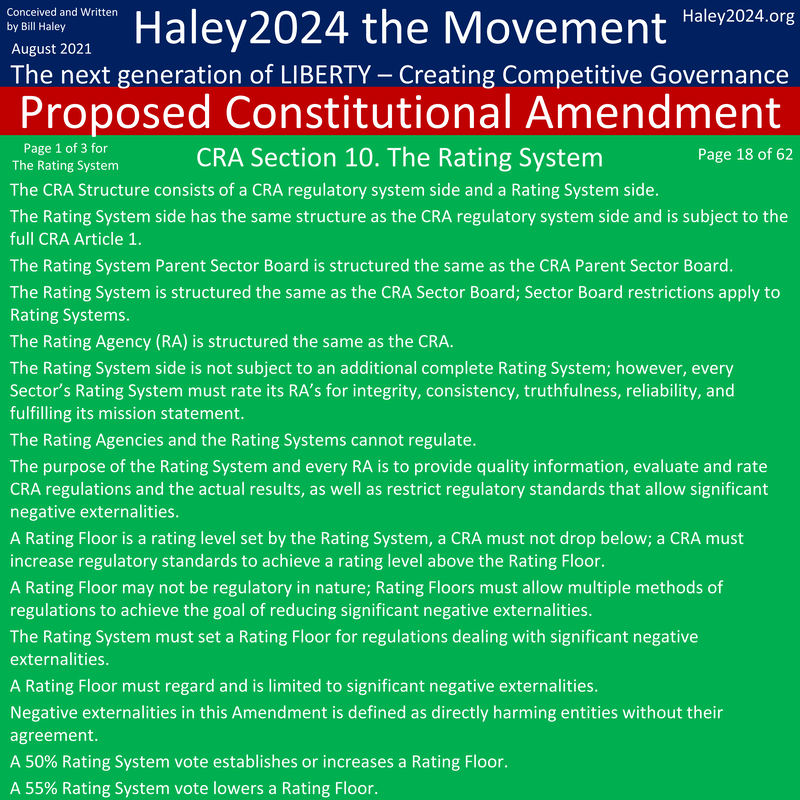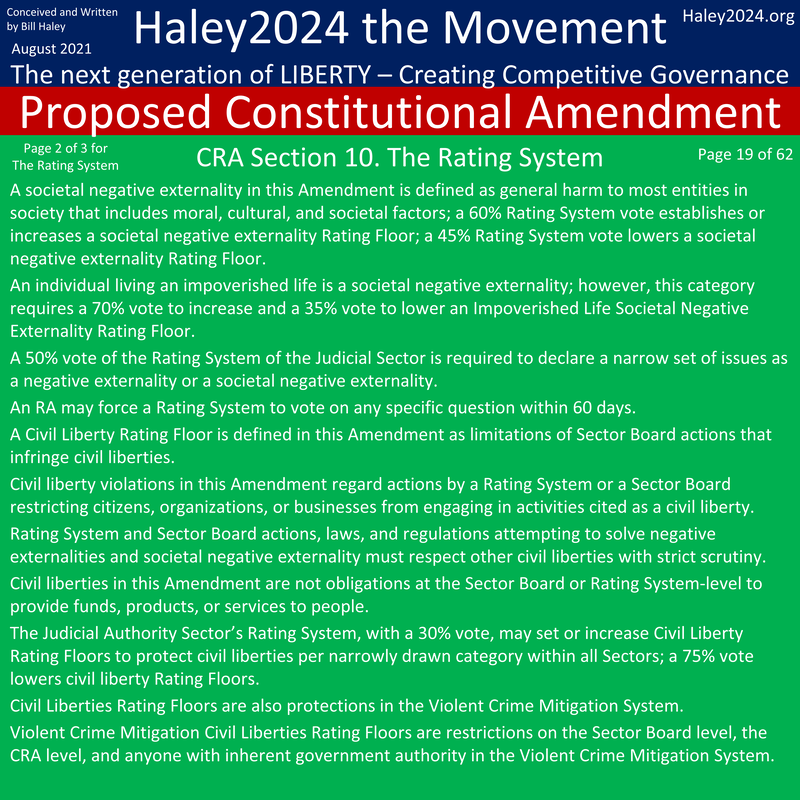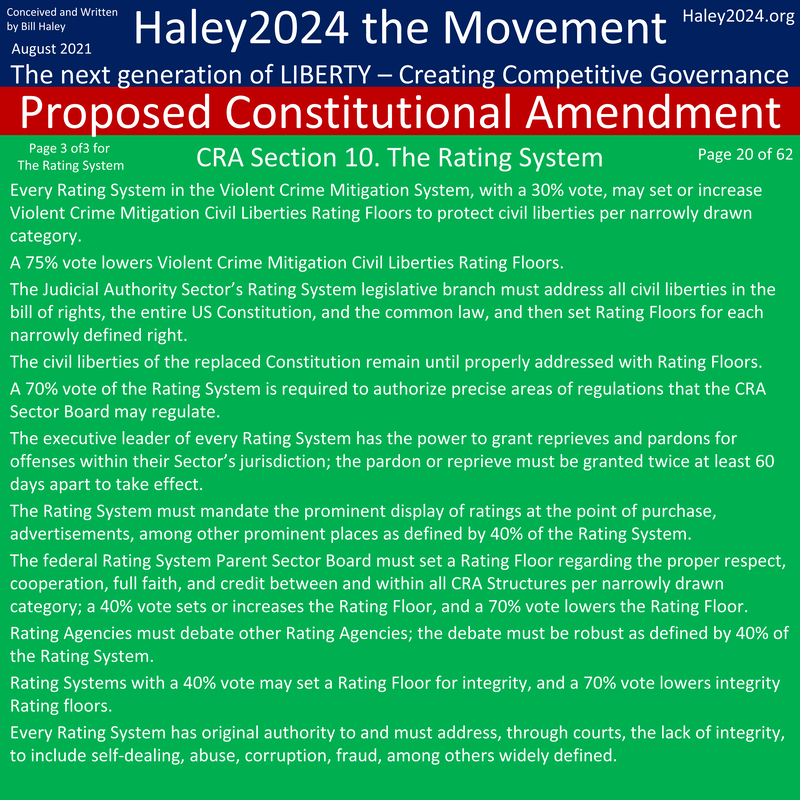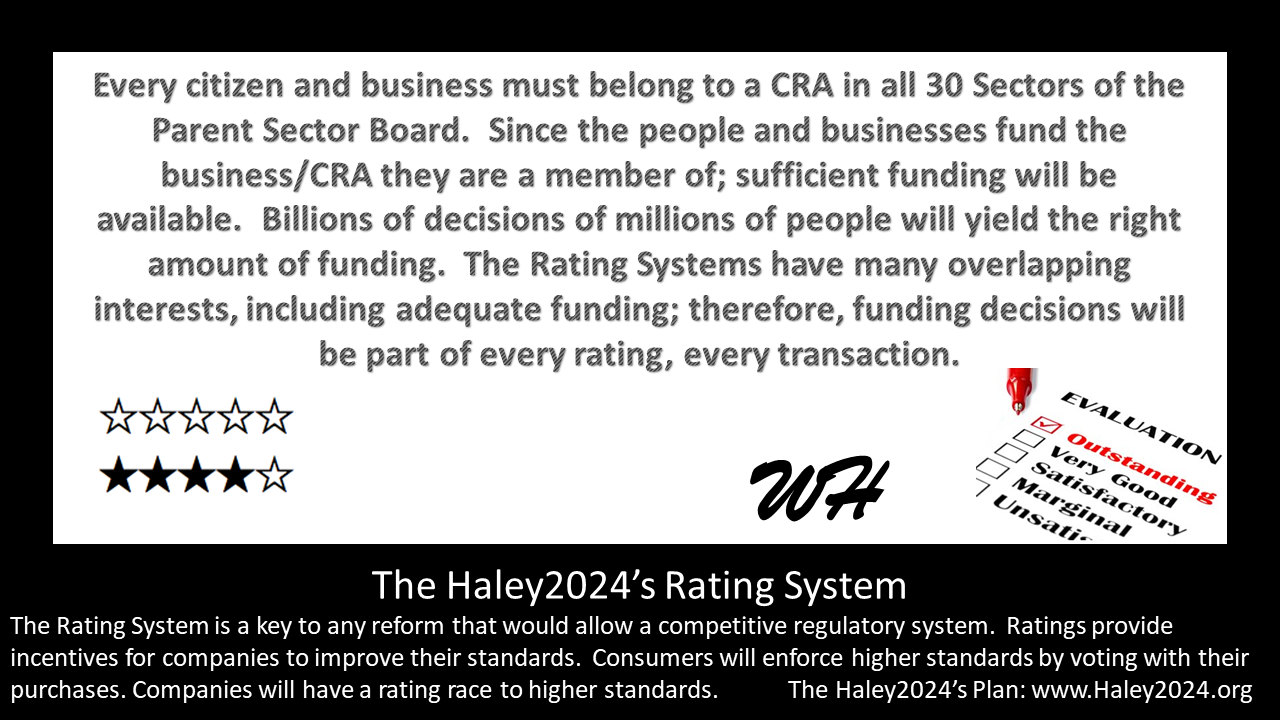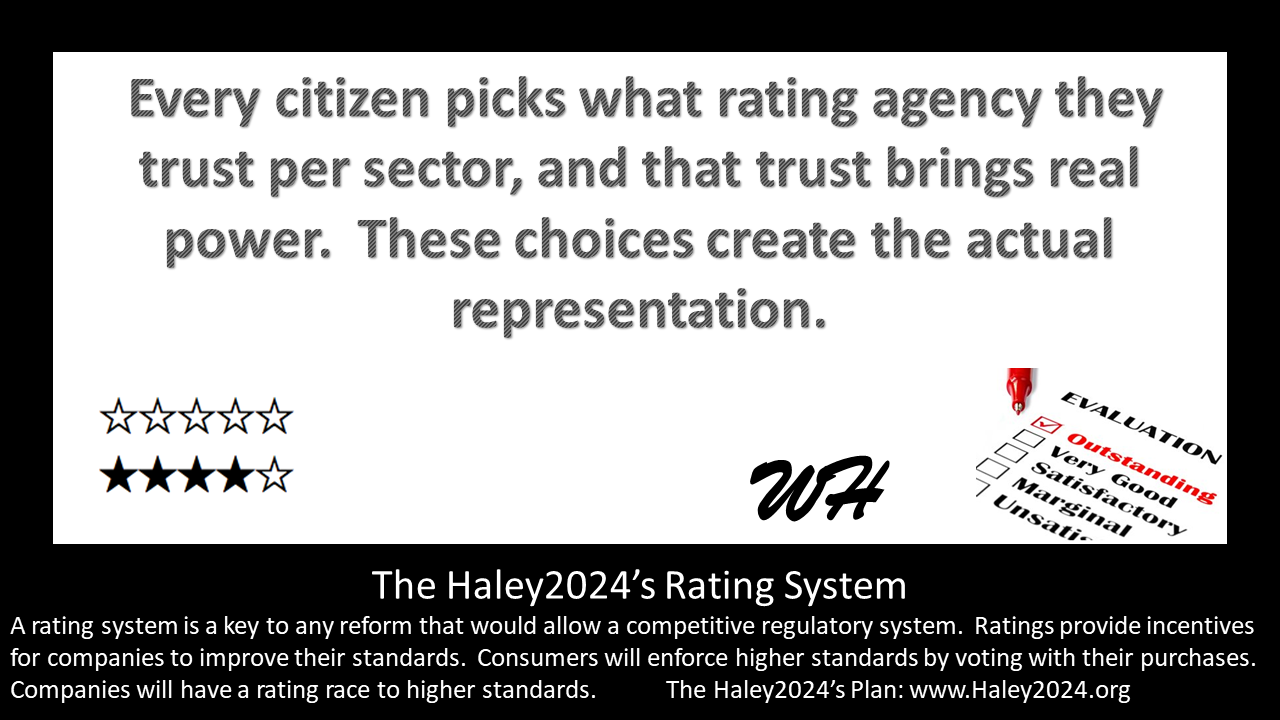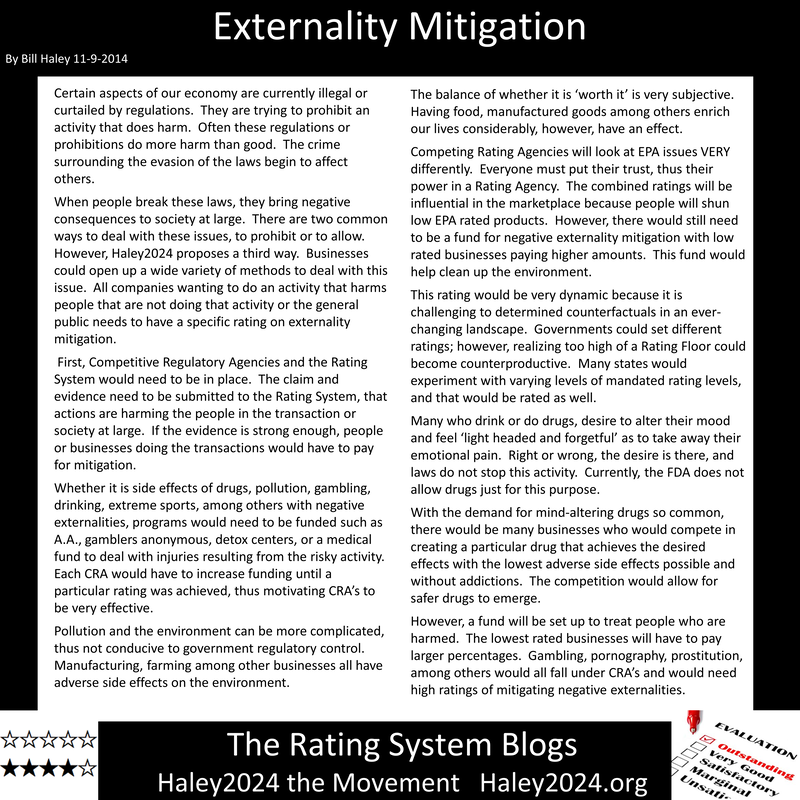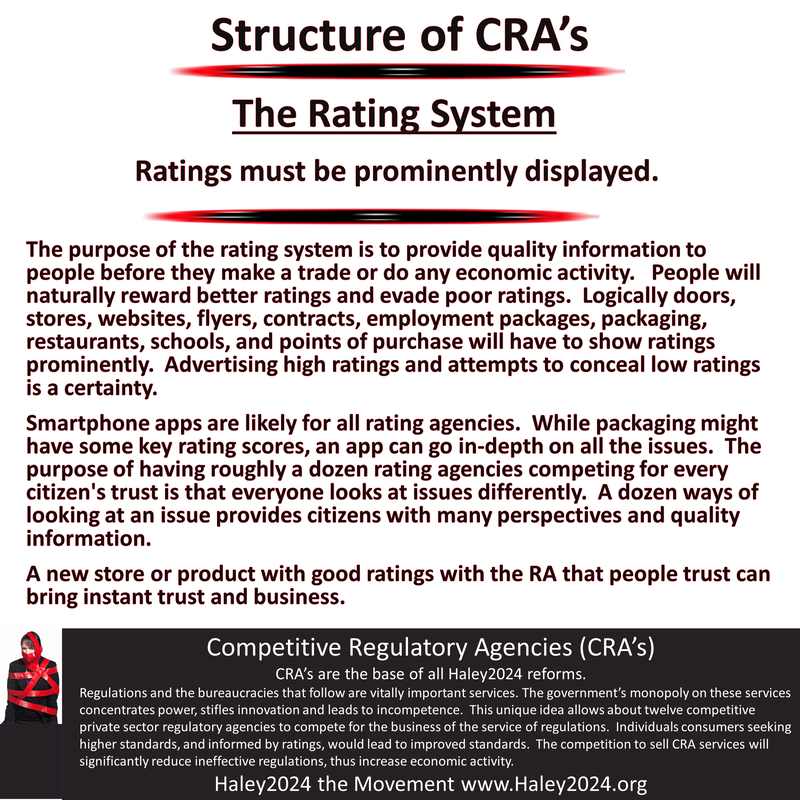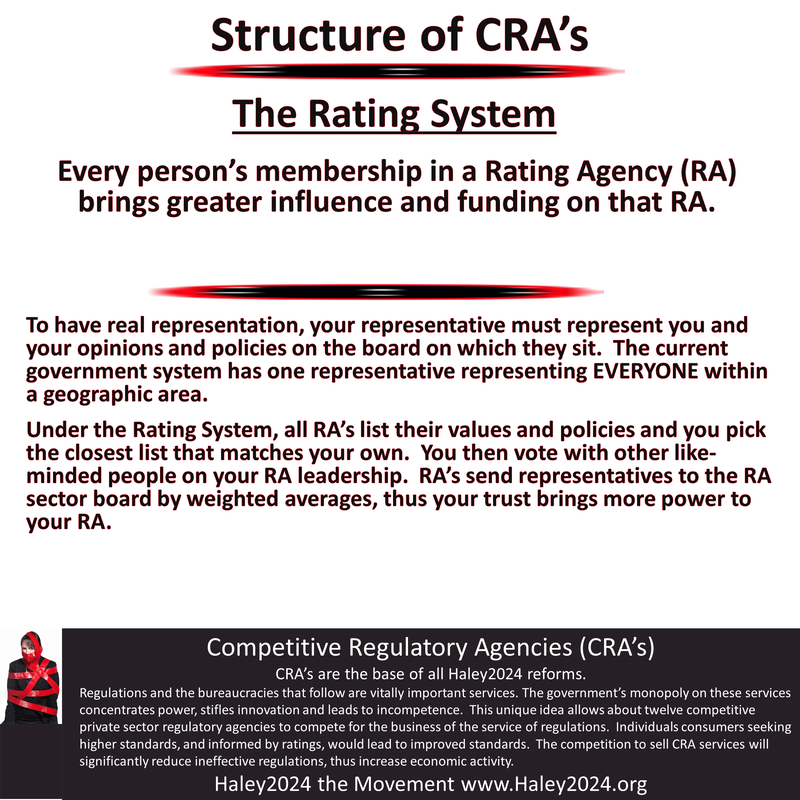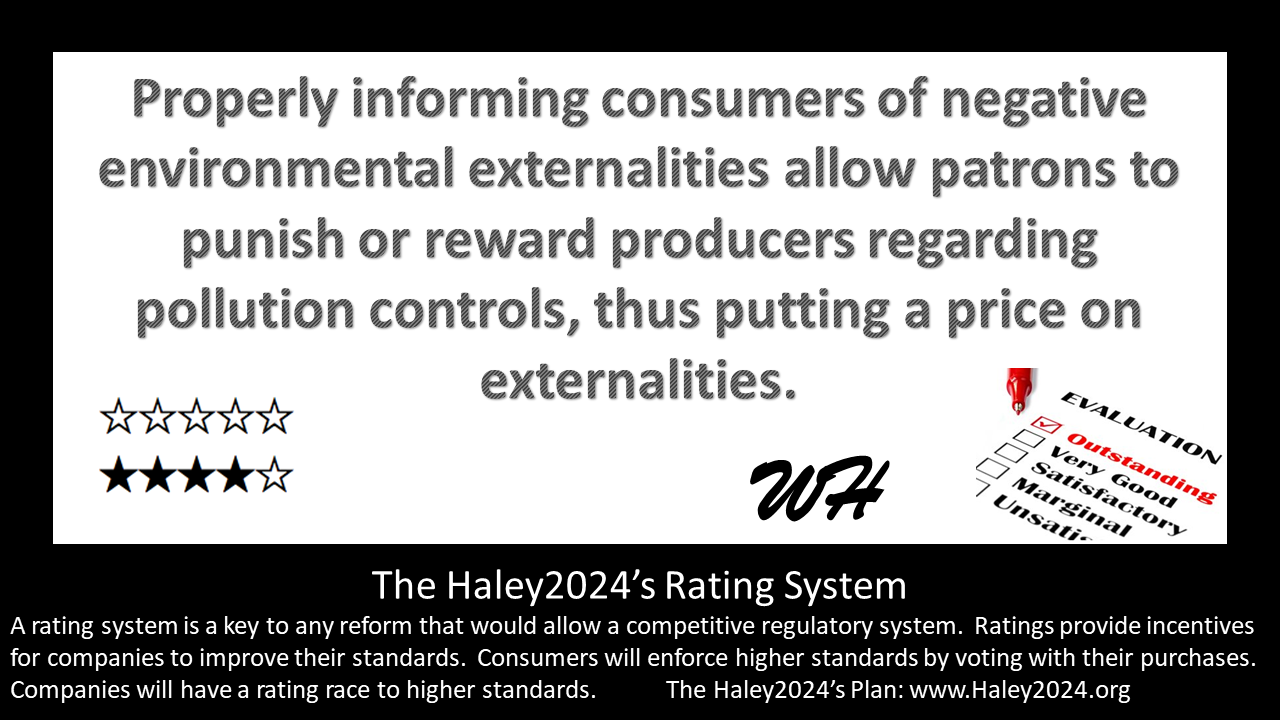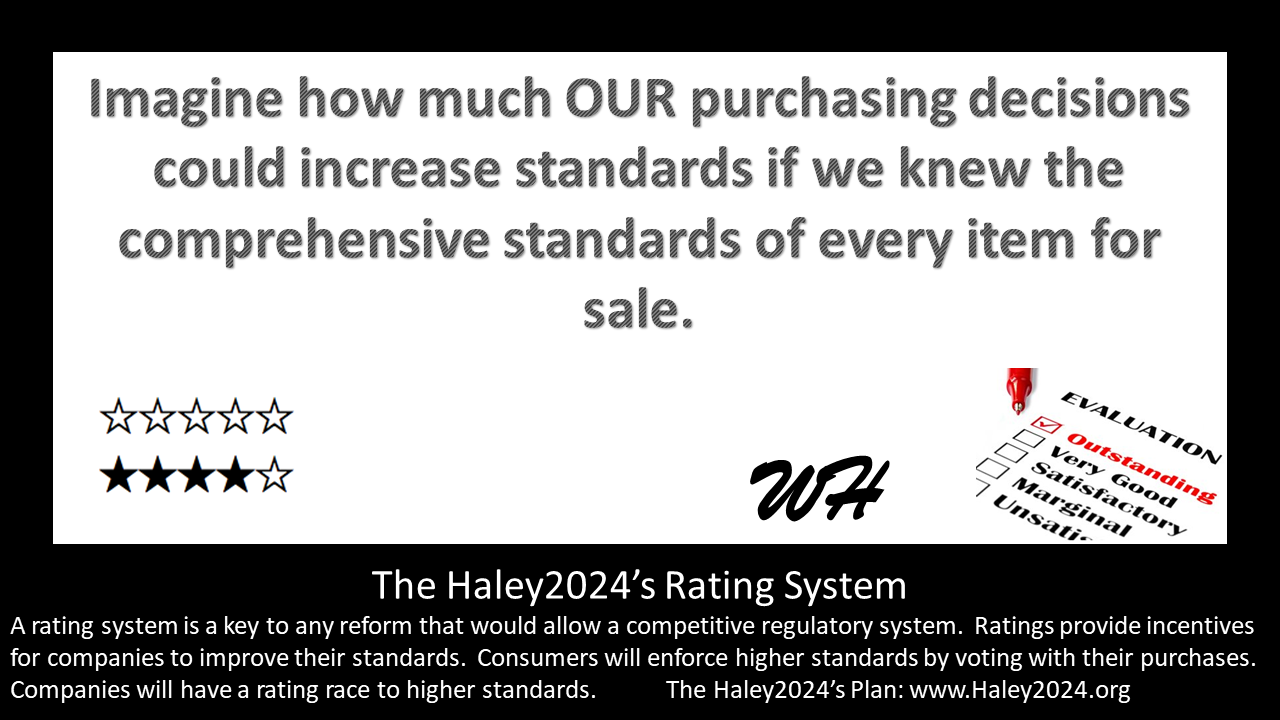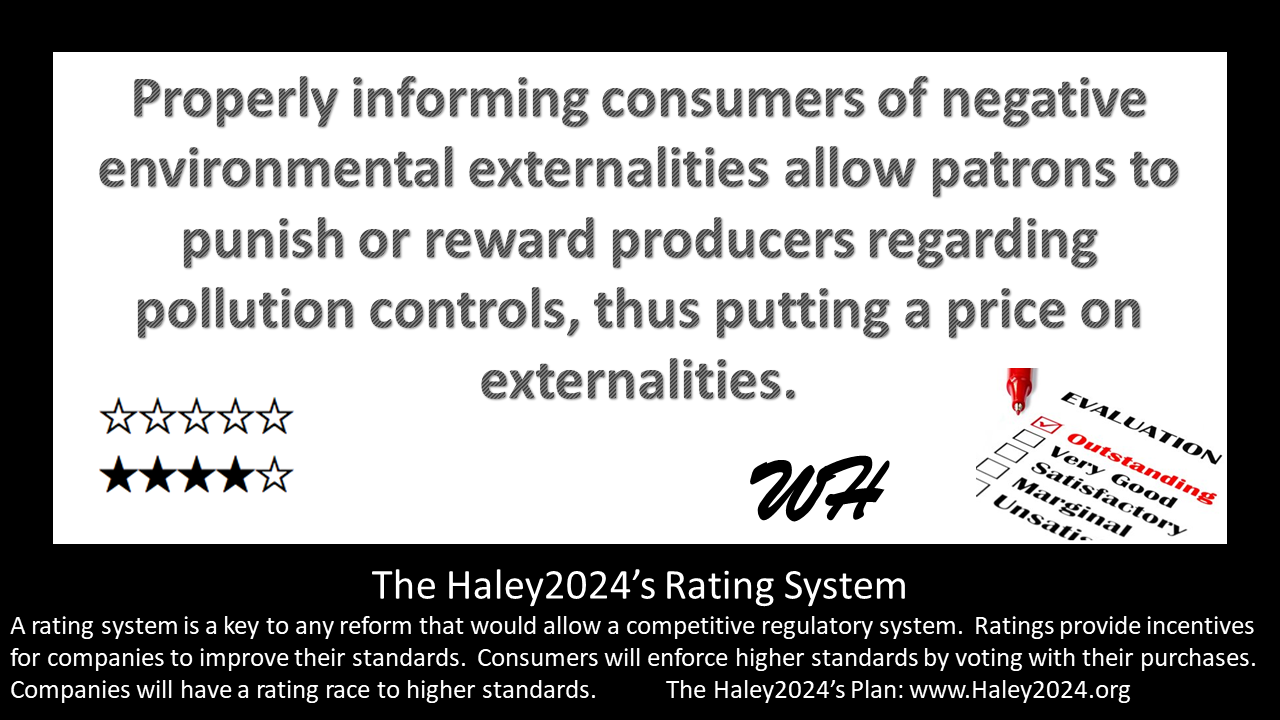The Rating System |
|
|
An RA concentrates strictly on its Sector.
Members of an RA determines how they will subjectively rate. Every citizen, business and organization MUST select and become a MEMBER of an RA. Join Just 5% of your city, state or all of America to create your own RA. Members of an RA vote on the legislative, executive and judicial leaders of their RA. |
|
The Rating System may set a Rating Floor dealing with negative externalities.
The Rating System standardizes the rating scales and display requirements. RA members elect their legislative and judicial representatives and send them with a proportional vote to the Rating System. RA members vote on the top Rating System executive. The Rating System has a court dealing strictly with low integrity. The CRA Sector Board may regulate, with a 70% vote, issues properly requested by the Rating System. |
|
The Rating System Parent Sector Board is structured the same as the CRA Parent Sector Board.
RA members elect their legislative and judicial representatives and send them with a proportional vote to the Rating System Parent Sector Board. RA members vote on the top Rating System Parent Sector Board executive. Roughly 360 RA’s: About 12 RA’s from each of the 30 Sectors make up the Rating System Parent Sector Board. This Board must ensure that the complete Rating System is staying within constitutional limitations and must address low integrity. The vast percentage of low integrity is handled at the Rating System level. |
The Concept of a
Rating System
Rating System
|
The purpose of this page is to teach that the free enterprise system works better when high-quality information is readily available. The rationale behind most laws is to reduce negative externalities. With quality information regarding how businesses mitigate negative externalities, consumers would naturally reward positive and punish negative externalities. This Rating System reduces the need for laws.
|
|
In the Haley2024 CRA Structure, most laws and regulations would be created in Competitive Regulatory Agencies (CRA’s). Every person and every business would be regulated only by their chosen CRA. Many different regulatory models would develop when everyone has roughly a dozen CRA’s to select from in each of the thirty Sectors.
|
|
There are multiple ways to regulate to achieve the desired result. The current monopoly control of regulation by politicians often eliminates many possible options. Regulations requiring specific building materials excludes all other possible materials. Requiring specific insurance plans precludes other insurance models. Requiring specific educational achievements to work in an industry inhibits other instructional models. Allowing a dozen CRA’s to approach regulation in different ways and then competing in the market place, allows the regulatory approaches to also compete.
|
|
|
The Rating Floor is a way to allow different regulatory approaches to deal with negative externalities; however, not allowing any approach to have such weak negative externality mitigation as to do significant harm to others. A Rating Floor might set a limit of X number of pollutants into the air and allow many approaches to attain that level instead of requiring a specific filter, thus eliminating other approaches.
|
|
The concept of the Haley2024 Rating System is key to any reform that would allow a competitive regulatory system. Ratings provide incentives for companies to improve their standards of safety, environmental impact, labor practices, among others. Low ratings will communicate low standards and will warn customers of a poor experience with a business. Consumers will enforce high standards by voting with their dollars. Companies will have a rating race to the top to attract business.
|
|
|
Investigators from various Rating Agencies will conduct investigations and collect information. RA’s will share raw data with all agencies. Analysts from each agency will study the data and give the business a rating based on the factors that each agency deems essential. The mandatory items are what the government currently regulates.
|
|
Rating Agencies (RA’s) investigators will likely have specific abilities to enter and have access to company documents relative to their quest for knowledge. Proper respect for sensitive or private information is vital. The details would be worked out, and the lack of transparency could lower ratings. The issue of confidential information would be very dynamic with different RA’s concerns varying widely.
|
|
|
There are many RA’s to create a spread of power. Different demographics of consumers may trust the opinions of different RA’s. Each Rating Agency (RA) will need memberships of at least 5% of all entities. An RA may not have memberships of more than 20% of all entities. There is a separate Rating System for all thirty CRA’s. Organization groups will become very helpful in grouping CRA’s and RA’s together under the same philosophies.
|
|
Some RA’s will look at outcomes and others might look at hard rules. Some people prefer equal opportunities and others prefer equal outcomes. Some people will want to ban or rate low what they do not like, and others will value the choices of others as valuable. Philosophies of how to rate will vary greatly. Therefore, multiple rating agencies will be vital to have useful information that people will trust. Some RA’s will be dynamic and consider second, third, and fourth order effects on regulations.
|
|
Too often people think that if the government does not regulate with hard rules, that standards would fall. Consumers have a desire for high standards and are willing to pay for them. They do not want to buy low standard food and desires a doctor with proper training. People are willing to pay more for improved animal conditions and producers with improved environmental standards. Stable banking is more valuable than shady institutions. Too often, consumers lack the knowledge of standards. Good RA’s will dig deep to inform the people of the good and bad. RA's would likely look at short and long-term effects.
|
|
When a citizen picks a Rating Agency (RA) to trust, that trust brings real power to that RA compared to the others. If one RA has the trust of 16% of the people and another had the trust of 8%, then the 16% RA will be weighted higher in the overall weighted ratings. The 16% RA would have 16% representation in the RA Sector Board. The 16% RA will get membership fees from 16% of the people and businesses. When an RA earns a citizen’s trust over roughly a dozen other RA’s, they are genuinely representing that citizen.
|
|
Funding would come from membership fees; however, business model funding is likely to replace those fees. It is essential to have a good start to the Rating System so people can quickly put their faith in the products that they buy, so tax money is likely needed to start the CRA system for the first year. Business model funding is currently robust in many areas of ratings. Business model funding for RA’s would likely reduce membership fees. Advertising would likely play a large funding role. Volunteer hours in the Charity Economy or working part-time for the RA would likely be available to pay for membership fees.
|
|
Most economic exchanges only affect the two or more parties involved. However, there are some that effects the greater population. Noise pollution from an airport, unsecured construction sites, too powerful radio waves, dangerous roads, dangerous drugs, chemical runoffs, bad cops, toxic smoke among others has potential to affect those outside the transaction. A 70% vote from the relevant RA Sector Board is needed to set a Rating Floor. On some issues, the 70% threshold is from the people within the geographic area most affected.
|
|
The power to be a cop is commanding and needs to have a strong board with great oversight. The Law Enforcement Authorization Sector Board (LEA) will issue badges of authorization. These badges will have different levels as training and experience warrant. RA's will play a role by supplying quality information.
Bad cops that infringe civil rights often will lose levels of authority or their badges altogether. The Law Enforcement RA you become a member of and give your trust to will provide you with true representation. A person’s Law Enforcement company, LEA and RA’s in many relevant Sectors will have greater power, the closer you are to your address. |
|
The power of the US military is immense and needs to have proper oversight. The elected leaders throughout all of history have not always been able to control the military if the military wishes to ‘take-over.’ The US has had better results; however, could use some additional checks and balances. True representation is when a citizen picks a person or group that represents them. Congress does not fit that definition.
The president should not have Commander and Chief powers without clear lines and an oversight group that can override the president if he or she commands their power outside those lines. Many dictators started off being elected and then crossed the lines without proper checks and balances that had the real power to stop the abuse. The Rating Sector Board’s Military Authorization Agency gives and takes authorization to private military businesses. |
|
The CRA’s Judicial powers will use private courts, however, will be constrained by the Judicial Authorities Rating Agencies. While there will be wide latitude on how different CRA will conduct their courts, they will have to respect civil rights. Rating Floors on many aspects of fair proceedings are vital. Those highly rated courts will likely attract more business while low rated courts go out of business. Experimentation, openness, information, and oversight will give consumers opportunities to force better policies.
|
|
The Rating System will never tell RA’s how to rate. However, it will be highly critical that we standardize to the same scales. Haley2024 recommends a 1–100 ratings with 100 being the best. The issues currently regulated by the government will start off as the needed issues to be rated. Experimentation will likely adjust what goes into the overall scores. Every RA can have their app so everyone can see the ratings of the RA that he or she trust. However, the rating scores on the products, contracts, doors, websites, ads, among others will be the weighted average of all the RA’s. The primary objective of the Rating System is to be useful to the consumer.
|
|
It is essential for society to protect Intellectual Property (IP). All 30 Sector Boards develop their IP regulations for their entire Sector. IP regulations are regulated in the Identity Sector because it deals with ownership rights. Every entity has to become a member of a CRA in every Sector including Sector Boards. Every Sector Board is different and has different IP protection requirements. Having thirty different models will create great experimentation that can be examples for others.
|
|
All environmental regulations will be taken away from the government and turned over to the Environmental Competitive Regulatory Agencies. Because pollution harms many, Rating Floors would be mandatory, however mostly unnecessary. Consumers will see every product’s comprehensive environmental ratings and choose higher rated products, thus forcing a price on pollution. The Environmental Sector has a lower representative vote to increase the Rating Floor; 50% versus 70%.
|


